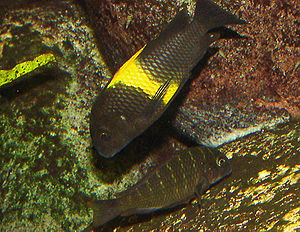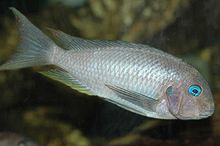Tropheus
| Tropheus | ||||||||||||
|---|---|---|---|---|---|---|---|---|---|---|---|---|

Tropheus spec. "Kiriza" and Tropheus moorii "Kachese" (below) |
||||||||||||
| Systematics | ||||||||||||
|
||||||||||||
| Scientific name | ||||||||||||
| Tropheus | ||||||||||||
| Boulenger , 1898 |
Tropheus is a genus of fish from the family cichlids (Cichlidae), which are endemic to the East African Lake Tanganyika . In the German-speaking countries they are colloquially called Brabant cichlids ,but very rarely today. The generic name Tropheus comes from trophos (Greek), which means something like wet nurse. Since there are a large number of color forms, the location is usually added to the species name for a clear description.
species
6 species of the genus have now been scientifically described:
- Tropheus annectens BOULENGER, 1900
- Tropheus brichardi NELISSEN & THYS, 1975
- Tropheus duboisi MARLIER, 1959
- Tropheus kasabae NELISSEN, 1977
- Tropheus moorii BOULENGER, 1898
- Tropheus polli AXELROD, 1977
There is also a large group of animals in this genus that cannot be clearly assigned to a species. They are called Tropheus spec. or Tropheus spec. aff. described, for example Tropheus spec. aff. moorii "Bemba" or Tropheus spec. aff. moorii "Moliro". The latter means that such specimens must probably be assigned to the species Tropheus moorii , but there is no scientific evidence. In the southern part of the lake there are at least three genetic lines ( clades ) that can be viewed as separate species, Tropheus sp. 'maculatus', Tropheus sp. 'Mpimbwe' and Tropheus sp. 'talk'.
anatomy
Depending on the species, the fish are between 12 and 16 cm tall and have a strong body with a pronounced chest area. They exist in many different color variants, most of which have a black or gray-brown base tone. The fins and the body pattern (for example, bandages and / or larger spots on the flank) are often bright and quite brightly colored. All species have a uniform horizontal stripe pattern up to the age of a few weeks. Its wide, not very deeply split mouth is set with two or three-pointed teeth.
Due to a lack of sexual dimorphism , males and females cannot be clearly distinguished on the basis of external characteristics. A closer look at the genital papilla, which is significantly larger in sexually mature females, often reveals this.
Way of life and diet
The habitat of Tropheus are the rocky and scree coasts of Lake Tanganyika, which have many hiding spots. The habitat ranges from areas with very large boulders to those in which only piles of rubble with relatively small rocks occur. In any case, the fish inhabit the upper, sun-drenched areas, since only there is a strong algae growth (growth) possible on the stones. With their specially shaped mouth, the cichlids graze this growth from the rocks. The herbivores can live up to 15 years. Therefore, when keeping an aquarium, it is important to ensure that predominantly plant-based food is fed, e.g. B. Spirulina flakes. Tropheus must not be fed red mosquito larvae under any circumstances, as these clog the digestive tract of the fish and lead to death.
Reproduction
Tropheus are ovophilic mouthbrooders in which the female takes care of the brood. During courtship , the male stands across in front of the female and shakes his entire body. If the female agrees, she spawns relatively large eggs on a flat surface and immediately takes them into her mouth. Then the couple takes a T-shaped position, with the male placing his genital opening in front of the female's mouth, releasing the sperm and thus fertilizing the eggs. After about 28 days, 5 to 15, but a maximum of 25 young animals leave the mother's mouth. The small fish are then between 10 and 12 mm in size.
General
They are popular, but not always easy to care for, aquarium fish that are often called "egg coals" by aquarists because of their color and body structure . They are usually kept in large groups as they develop strong intraspecific aggression in the pelvis. The strong interspecific disputes also lead to certain difficulties in the offspring that can not be compared with the so-called Mbunas . The breeder can very often only succeed in breeding without losing the female if the young fish are carefully removed from the mother's mouth shortly before leaving this female shelter for the first time. This procedure should be carried out at night so that the female caring for it is not rushed to death by the other pool occupants. Usually females of other species are separated after the egg ingestion in order to obtain higher breeding numbers. This is hardly possible with the Tropheus species, as female animals after a long absence are followed by the group even in large tanks until they die. Another option is group breeding and rearing. Lots of hiding and resting options such as shelters and small crevices (for young animals) are necessary. In this way, the females and young animals can be left in the group and the stress for the animals when removing the young fish is eliminated. Young females are often unable to carry or release their brood as many breeders remove the young from the females. The females have forgotten how to care for the brood. Often three or four spawning courses are necessary before breeding works.
literature
- Peter Schupke: Aqualog: African cichlids II, Tanganjika I, Tropheus . ACS Verlag., Rodgau.
- Pierre Brichard: Atlas of Lake Tanganyika Cichlids . Bede Verlag., Ruhmannsfelden 1997.
- Hans-Joachim Herrmann: Tropheus . Dähne Verlag., Ettlingen 1997.
- Wolfgang Staeck, Horst Linke: Cichlids from East Africa . Tetra Verlag., Berlin 1981.
- Hans-Joachim Herrmann: The Cichlids of the Old World Tanganyika Lake . Ulmer Verlag., Stuttgart.
- Frank Schneidewind: Tropheus cichlids . Bede Verlag., Ruhmannsfelden 1999.
Individual evidence
- ↑ Van Steenberge, M., Raeymaekers, JAM, Hablützel, PI, Vanhove, MPM, Koblmüller, S. & Snoeks, J. (2018): Delineating species along shifting shorelines: Tropheus (Teleostei, Cichlidae) from the southern subbasin of Lake Tanganyika. Frontiers in Zoology, 15:42 . Doi: 10.1186 / s12983-018-0287-4
Web links
- Tropheus on Fishbase.org (English)

